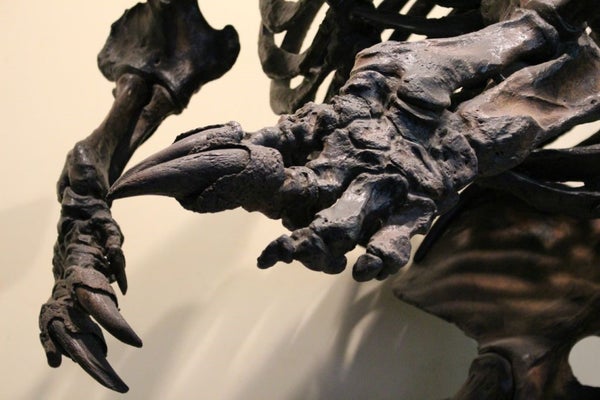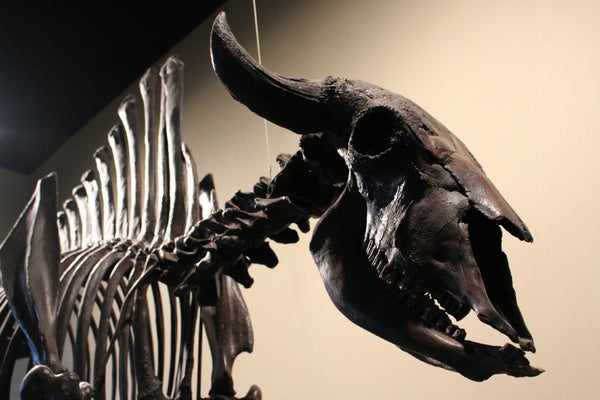This article was published in Scientific American’s former blog network and reflects the views of the author, not necessarily those of Scientific American
I can’t help the impulse. Whenever I’m hiking through the western forests, prairies, and deserts, my mind conjures up images of Ice Age beasts. I guess I keep engaging in the fantasy because I know I just missed them. Native peoples saw them, and even consumed them, but I'm too late, even if just by a little bit. Ten thousand years is nothing from a geologic perspective. Shasta ground sloths wouldn’t seem out of place shuffling through groves of Joshua trees, mastodons should still be cracking conifer boughs in the woods, and the grasslands were so recently the place where deer, antelope, and camels played.
But the places I scuff my boots aren’t the same as they were back in the heyday of North America’s enormous herbivores. While there have only been a few clicks of the Cosmic Clock since the end of the Pleistocene, the world hasn’t remained in stasis as if waiting for the return of our missing megafauna.
In fact, as Elisabeth Bakker, Jacquelyn Gill, and others argue in a 2015 review, the extinction of the great Ice Age beasts has created a world dramatically different than the one roamed by shaggy proboscideans and enormous sloths.
On supporting science journalism
If you're enjoying this article, consider supporting our award-winning journalism by subscribing. By purchasing a subscription you are helping to ensure the future of impactful stories about the discoveries and ideas shaping our world today.
Herbivores are plant predators. It might be strange to think of them that way. A horse plucking up grass or an elephant chawing a mouthful of leaves isn’t as violent or gory a spectacle as a pack of wolves taking down an elk. Yet ecologists call the feeding habits of herbivores “predation” for good reason. The interactions may be slower and harder to see, and there is cooperation in addition to competition, but there are still arms races between herbivores and the plants they rely on. And this constant shuffle is what helps create the landscapes we see all around us.
Consider the American mastodon. This “bubby toothed” elephant was a browser, preferring tree branches and other woody vegetation to the diet of grass enjoyed by its distant cousin, the woolly mammoth. But the mastodon didn’t just eat trees and shrubs. The beast would have trampled down paths through the woods and scraped its tusks against tree trunks, further altering the landscape around it by stamping out some young plants and hindering the growth of others. Mammut americanum altered the world through its habits.
Such beasts, Bakker and coauthors write, were ecosystem engineers.
The same was true of many other herbivores that lived around the world until very recently. Up until about 600 years ago, for example, giant, flightless birds called moas browsed in the forests of New Zealand, helping to create openings in the woodlands that allowed light-sensitive plants to thrive in the patches they opened up. Since their disappearance, however, the forest has closed, with wire plants—whose springy anatomy made them resistant to moa depredations—spreading in greater numbers.

The claws of Harlan's ground sloth. Credit: Brian Switek
Modern, short-term experiments have shown the same pattern. When big herbivores are either eliminated or excluded from an area, Bakker and colleagues write, the woodlands start to close up. Not as many young plants are being pulled up and fewer adult plants struggle to put out leaves against the onslaught of big browsers.
Consider pachyderms. Experimental studies have shown that areas where African elephants have been excluded can host 42% more trees than when the mammals are stripping them and pushing them over. Through extinction and the restriction of our last few megaherbivores to parks and game reserves, we’re playing out a miniature version of what happened when the Pleistocene’s major plant predators went extinct.
So when I set out from my Salt Lake City apartment and climb up above the level of the Lake Bonneville shoreline, to where my Ice Age inspirations used to roam, I need to do more than picture Harlan’s ground sloth or a mastodon trundling through the stands of oak and aspen. I need to think about what those herbivores did. Of branches stripped bare, toppled trunks, and wide paths through the woods pressed down by the hungry herbivores.
The lost megafauna weren’t just charismatic characters from a closed act in Earth’s history. They helped make the world what it was. I am only sorry that I can’t see what they created.
Reference:
Bakker, E., Gill, J., Johnson, C., Vera, F., Sandom, C., Asner, G., Svenning, J. 2015. Combining paleo-data and modern exclosure experiments to assess the impact of megafauna extinctions on woody vegetation. PNAS. doi: 10.1073/pnas.1502545112
[This post was originally published at National Geographic.]
